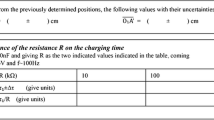Abstract
Learning to understand the content and meaning of physics’ concepts is one of the main goals of physics education. In achieving this understanding, the creation of quantities through quantitative measurements, or rather through quantifying experiments, is a key process. The present article introduces a didactical reconstruction for understanding the construction of the meaning of physical quantities from a network point of view, where the quantities are part of networks and the quantifying experiments build up these networks. As a practical example, we discuss how the quantity temperature is constructed in an instructional unit designed for student teachers and what the learning outcomes are.
Similar content being viewed by others
References
Bagno E., Eylon B.-S., Ganiel U. (2000). From Fragmented Knowledge to a Knowledge Structure: Linking the Domains of Mechanics and Electromagnetism. American Journal of Physics 68:S16–S26
Carlton K. (2000). Teaching about Heat and Temperature. Physics Education 35:101–105
Chang H. (2004). Inventing Temperature: Measurement and Scientific Progress. Oxford University Press, Oxford
Cotignola M.I., Bordogna C., Punte G., Cappannini O.M. (2002). Difficulties in Learning Thermodynamic Concepts: Are They Linked to the Historical Development of this Field? Science & Education 11:279–291
diSessa A., Sherin B.L. (1998). What Changes in Conceptual Change? International Journal of Science Education 20(10):1155–1191
Erlichson H. (2001). Kelvin and the Absolute Temperature Scale. European Journal of Physics 22:325–328
Giere R.N. (1999). Science Without Laws. The University of Chicago Press, Chicago
Izquierdo-Aymerich, M., Adúriz-Bravo, A.: 2003, ‘Epistemological Foundations of School Science’, Science & Education 12, 27–43
Koponen, I.T. & Mäntylä, T.: 2006, ‘Generative Role of Experiments in Physics and in Teaching Physics: A Suggestion for Epistemological Reconstruction’, Science & Education 15, 31–54
Koponen I.T, Mäntylä T., Lavonen J. (2004). The Role of Physics Departments in Developing Student Teachers’ Expertise in Teaching Physics. European Journal of Physics 25:645–653
Meltzer D. (2004). Investigation of Students’ Reasoning Regarding Heat, Work, and the First Law of Thermodynamics in an Introductory Calculus-based General Physics Course. American Journal of Physics 73:1432–1446
Novak J.D., Gowin D.B. (1984). Learning How to Learn. Cambridge University Press, Cambridge
Reif F. (1987). Instructional Design, Cognition and Technology: Applications to the Teaching of Scientific Concepts. Journal of Research in Science Teaching 24:309–324
Reif F. (1995). Millikan Lecture 1994: Understanding and Teaching Important Scientific Thought Processes. American Journal of Physics 63:17–32
Taber K. (2000). Finding the Optimum Level of Simplification: The Case of Teaching about Heat and Temperature. Physics Education 35:320–325
Thagard P. (1992). Conceptual Revolutions. Princeton University Press, Princeton
Trowbridge J.E., Wandersee J.H. (1998). Theory-Driven Graphical Organizers. In: Mintzes J.J., Wandersee J.H. and Novak J.D. (eds) Teaching Science for Understanding: A Human Constructivistic View. Academic Press, San Diego
Van Heuvelen A. (1991). Learning to Think Like a Physicist: A Review of Research-based Instructional Strategies. American Journal of Physics 59:891–897
Acknowledgements
We would like to thank Prof. Jari Lavonen for helping us in gathering and analysing the data, and also for many inspiring and helpful discussions concerning our work.
Author information
Authors and Affiliations
Corresponding author
Rights and permissions
About this article
Cite this article
Mäntylä, T., Koponen, I.T. Understanding the Role of Measurements in Creating Physical Quantities: A Case Study of Learning to Quantify Temperature in Physics Teacher Education. Sci Educ 16, 291–311 (2007). https://doi.org/10.1007/s11191-006-9021-2
Received:
Accepted:
Published:
Issue Date:
DOI: https://doi.org/10.1007/s11191-006-9021-2




